#NASA surface habitat
Link
**Hosts:** Steve Dunkley and AI Assistant Hallie
---
**Episode Summary:**
Today's episode of Astronomy Daily takes us from the moon to Mars and beyond! Steve Dunkley and his AI co-host Hallie discuss an array of space exploration topics, including the challenges faced by Japan's Slim moon lander, SpaceX's unique Cygnus spacecraft launch, and the unexpected arrival of an asteroid. Plus, we pay tribute to NASA's Ingenuity helicopter, which has soared beyond expectations on the Red Planet.
---
**Featured Topics:**
1. **Japan's Slim Moon Lander:** A look into the upside-down predicament of Japan's Slim lander on the moon and the hopeful recovery efforts by JAXA.
2. **SpaceX's Cygnus Mission:** The details behind SpaceX's preparation for launching the Cygnus spacecraft, including a special hatch for late cargo additions like astronaut ice cream.
3. **Asteroid 2024 BX1:** The fascinating story of how astronomers predicted the impact of an asteroid mere hours before it lit up the skies over Germany.
4. **Ingenuity's Final Flight:** A solemn yet celebratory discussion on the end of NASA's Ingenuity helicopter's mission on Mars after an unprecedented 72 flights.
---
**Notable Quotes:**
- "For a helicopter that's overperformed the way that this has, I don't think you can really mourn it and be sad." - Havard Fayer Grip, Ingenuity's Chief Pilot
- "We humans are a weird mob. You certainly are. But it's nice to know you still care." - Steve Dunkley and AI Assistant Hallie sharing a moment of reflection on Ingenuity's mission.
---
**Additional Information:**
Listeners can dive deeper into the universe of space news by subscribing to the Astronomy Daily newsletter at bitesz.com and spacenuts.io. Plus, explore the full library of Astronomy Daily episodes and catch up with the parent podcast, Space Nuts, for even more cosmic content.
---
**Next Episode Preview:**
Don't miss the next episode, where Steve and Hallie will bring you more thrilling stories from the cosmos. And be sure to catch Tim Gibbs this Friday for another stellar update from the Astronomy Daily newsletter.
---
**Closing Remarks:**
Thank you for joining us on this interstellar journey through the latest in space exploration. Remember to keep looking up and imagining the possibilities that lie within our vast universe. Until next time, this is Steve Dunkley, wishing you clear skies and bold adventures.
---
**Host Sign-off:** Steve Dunkley: "See you in the cosmos!" Hallie: "Farewell, fellow stargazers.
#asteroid#cygnus#habitat#helicopter#ingenuity#international#japanese#jaxa#lander#launch#lunar#mars#moon#nasa#orbit#space#spacecraft#spacex#surface#tracking
1 note
·
View note
Note
What do you mean by Venus floating cities?
I'm hoping to write a science fiction story about visiting Venus as part of the space race and I would love your input
Alright so the thing with Venus is that we're all very familiar with her horrible hell-death clouds and 900°F surface temperatures. We all understand the surface of Venus is not a fun place for humans to be.
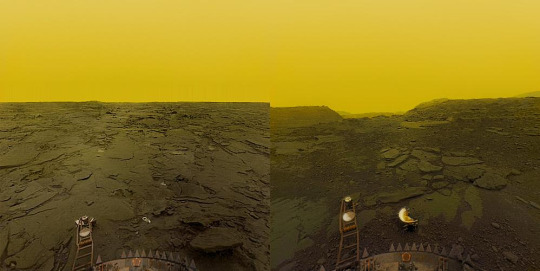
But, nobody ever talks about the fact that ABOVE the hell-death clouds, Venus is a paradise. The most Earth-like environment we know of in the solar system, beyond Earth itself, is actually in the skies of Venus.
About 30 miles above the surface, the pressure is ~1 atmosphere, and the temperature ranges from 30 - 100°F, which is Happy Human™ standard pressure and temperature.
What's more, a breathable mix of oxygen and nitrogen provides over 60% the lifting power on Venus that helium does on Earth. In other words, a balloon full of human-breathable air would float to the habitable range of Venus's atmosphere. We could float a ship with the very air we breathe.
The other great thing about this is that it avoids one of the big problems with Mars colonization. On Mars, any habitat on the surface full of breathable air is vulnerable to leaks and explosive decompression, a la the Martian.

Floating on Venus, a balloon full of breathable air doesn't have a significant pressure difference between the inside and the outside. Which means, any leaks or tears would be very slow and manageable. You could fix that shit with duct tape!
Similarly, because the environment outside the balloon is so Earth-like, humans living there wouldn't need any big fancy pressurized suits for extravehicular work. We'd need air to breathe, maybe some heat protection, and protection against the acid rain. That's it.
Venus also provides the tools to keep us fed! It's atmosphere is made primarily of carbon dioxide, even above the dense horrible clouds. What likes carbon dioxide? Plants from Earth!! Lets grow FOOD on FLOATING PLATFORMS in the SKIES of VENUS.
This whole idea actually came out of a NASA effort exploring potential Venus colonization. The program was called HAVOC - the High Altitude Venus Operational Concept.
It hasn't really gone anywhere, and as far as I know there are no real plans to revisit it. Unfortunately, from a practicality standpoint, Mars is a much more viable target for human colonization. Not only is it better poised for outer solar system exploration, being farther away from the sun, but living on Venus would come with too many complicated contingencies. In the event of a major failure on Venus, you'd need to fly to another base, or fuck off all the way to orbit. I understand why people aren't really in a hurry to live somewhere where landing on the surface means certain death.
But that doesn't mean I won't be forever and always enamored by the skies of Venus. Here's one of the artist concepts to come out of HAVOC.

I want to be there.
#venus#nasa#space#space exploration#HAVOC#blimp#spost#venus my beloved#single most underrated planet#asked and answered
7K notes
·
View notes
Text
Small Device Currently on Mars Is Generating as Much Oxygen as a Tree, Scientists Reveal
Luckily for these pioneering astronauts though, it looks like one of the heaviest—and most important—resources will be provided on site: oxygen. In fact, a lunchbox-sized device currently on the surface of Mars is already reliably generating as much oxygen as a tree, scientists revealed on Wednesday.
Oxygen will be important not only to provide astronauts breathable air when they’re off-planet but also to help fuel rockets to eventually take them back to Earth. In a new paper published on Wednesday in the journal Science Advances, researchers from MIT explain how a small experiment roaming Mars on the back of NASA’s Perseverance rover is proof that it's possible to create oxygen from the Martian atmosphere.
This experiment is also the first to successfully harvest and use resources on any planetary body, a process that will be important not only for Martian exploration but future lunar habitats as well.
#science#Moxie has been my favorite tech experiment on that mission since the start#high hopes being fulfilled#mine#space
5K notes
·
View notes
Text
What Makes the Artemis Moon Mission NASA's Next Leap Forward?
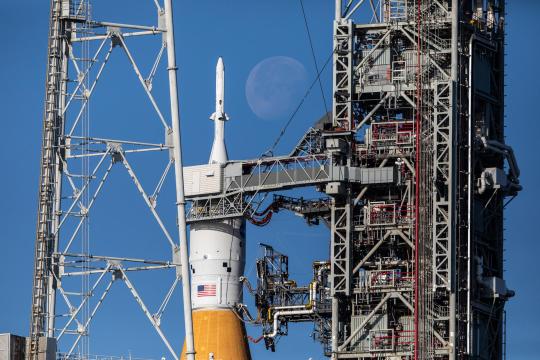
When NASA astronauts return to the Moon through Artemis, they will benefit from decades of innovation, research, and technological advancements. We’ll establish long-term lunar science and exploration capabilities at the Moon and inspire a new generation of explorers—the Artemis Generation.
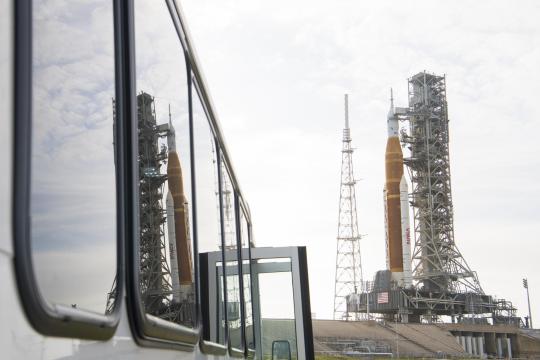
Meet the Space Launch System rocket, or SLS. This next-generation super heavy-lift rocket was designed to send astronauts and their cargo farther into deep space than any rocket we’ve ever built. During liftoff, SLS will produce 8.8 million pounds (4 million kg) of maximum thrust, 15 percent more than the Saturn V rocket.
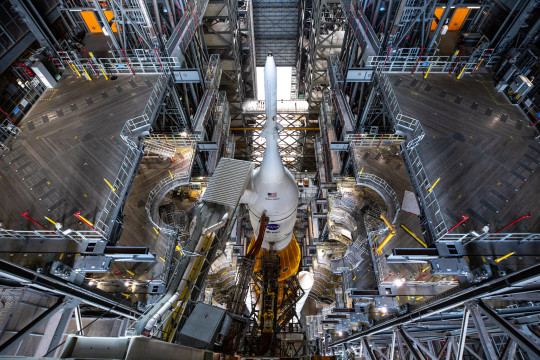
SLS will launch the Orion spacecraft into deep space. Orion is the only spacecraft capable of human deep space flight and high-speed return to Earth from the vicinity of the Moon. More than just a crew module, Orion has a launch abort system to keep astronauts safe if an emergency happens during launch, and a European-built service module, which is the powerhouse that fuels and propels Orion and keeps astronauts alive with water, oxygen, power, and temperature control.
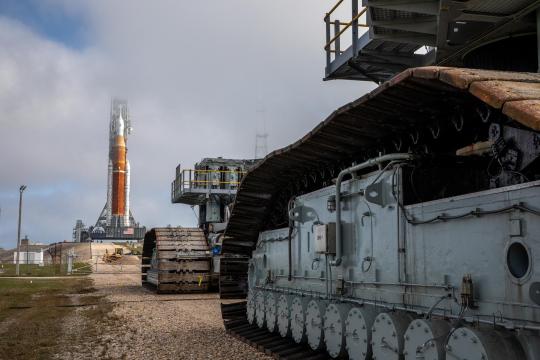
Orion and SLS will launch from NASA’s Kennedy Space Center in Florida with help from Exploration Ground Systems (EGS) teams. EGS operates the systems and facilities necessary to process and launch rockets and spacecraft during assembly, transport, launch, and recovery.

The knowledge we've gained while operating the International Space Station has opened new opportunities for long-term exploration of the Moon's surface. Gateway, a vital component of our Artemis plans, is a Moon-orbiting space station that will serve as a staging post for human expeditions to the lunar surface. Crewed and uncrewed landers that dock to Gateway will be able to transport crew, cargo, and scientific equipment to the surface.
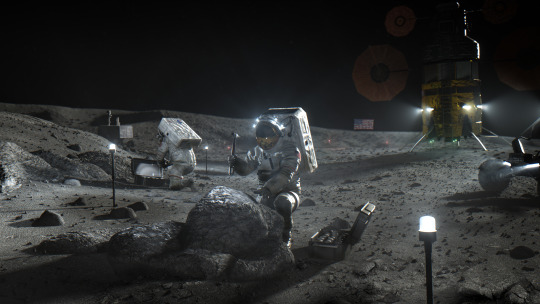
Our astronauts will need a place to live and work on the lunar surface. Artemis Base Camp, our first-ever lunar science base, will include a habitat that can house multiple astronauts and a camper van-style vehicle to support long-distance missions across the Moon’s surface. Apollo astronauts could only stay on the lunar surface for a short while. But as the Artemis base camp evolves, the goal is to allow crew to stay at the lunar surface for up to two months at a time.

The Apollo Program gave humanity its first experience traveling to a foreign world. Now, America and the world are ready for the next era of space exploration. NASA plans to send the first woman and first person of color to the lunar surface and inspire the next generation of explorers.
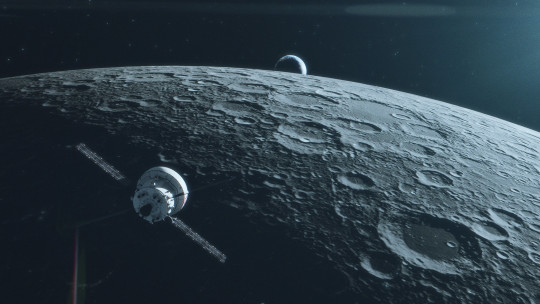
Our next adventure starts when SLS and Orion roar off the launch pad with Artemis I. Together with commercial and international partners, NASA will establish a long-term presence on the Moon to prepare for missions to Mars. Everything we’ve learned, and everything we will discover, will prepare us to take the next giant leap: sending the first astronauts to Mars.
Make sure to follow us on Tumblr for your regular dose of space!
1K notes
·
View notes
Text
CAN HUMANS SURVIVE ON MARS??
Blog#367
Wednesday, January 17th, 2024.
Welcome back,
As Earth's closest neighbors in the solar system, Mars and Venus have been objects of fascination for centuries. With the advent of space exploration and growing concerns about Earth's sustainability, the idea of human habitation on these planets is becoming less science fiction and more a potential future reality. Could we, as a species, survive on Mars?
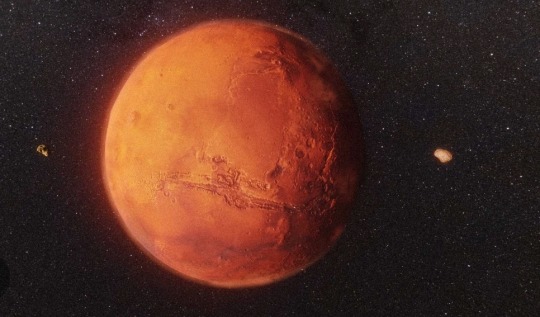
To answer this question, we must understand the distinct challenges and potential solutions that each planet presents.
Mars, often called the Red Planet due to its reddish appearance from iron oxide (rust) on its surface, is the most Earth-like planet in our solar system.

It has a 24.5-hour day, polar ice caps, seasons, and a variety of geographical features similar to Earth's. NASA's Mars rovers, including the recent Perseverance, have found evidence of ancient water flows, leading to speculation that Mars could once have supported life.
Despite these similarities, Mars poses significant challenges for human survival. Its thin atmosphere, primarily composed of carbon dioxide, offers little protection from solar radiation.

Mars' surface temperature varies widely, with summer days at the equator reaching a comfortable 20°C (70°F), but dropping to a frigid -73°C (-100°F) at night. The planet's low atmospheric pressure (less than 1% of Earth's) makes liquid water unstable at the surface.
To live on Mars, we would need technology to protect us from radiation, supply breathable air, and provide warmth. Scientists and engineers are exploring solutions such as building habitats underground or using Martian soil to shield against radiation.
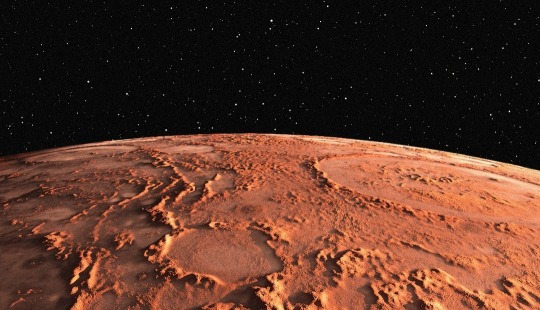
To generate oxygen, NASA's Perseverance rover carried an experiment called MOXIE (Mars Oxygen In-Situ Resource Utilization Experiment) that successfully produced oxygen from Mars' carbon dioxide-rich atmosphere. Life support systems could potentially extract water from ice at Mars' poles or in the ground.
Originally published www.miragenews.com
COMING UP!!
(Saturday, January 20th, 2024)
"WHY ARE THE BLACK HOLES INVISIBLE??"
#astronomy#outer space#alternate universe#astrophysics#universe#spacecraft#white universe#space#parallel universe#astrophotography#moon mars#mars
57 notes
·
View notes
Text
With NASA gearing up to send humans back to the moon in the next few years with the Artemis missions with the goal of establishing a permanent outpost at the lunar south pole, nations are making efforts to contribute to Artemis and a permanent presence on our nearest celestial neighbor.
Recently, the Italian Space Agency, formally known as Agenzia Spaziale Italiana (ASI), has taken steps to establish the first permanent outpost on the lunar surface, known simply as the Multi-Purpose Habitat (MPH). This endeavor was officially kicked by the ASI signing a contract with the French-based aerospace company, Thales Alenia Space, who specializes in space-based systems, including ground segments and satellites used for both Earth observation and space exploration.
Continue Reading.
45 notes
·
View notes
Text
Space Case
The first chapter of my contribution for the Invisobang is now out! You can read it here or on my AO3.
Artwork by the amazing MinnowMarsh and Amar Art!
Summary:
Danny runs into some astronauts from NASA’s lunar mission while trying to do his homework on the moon. This leads to new friends, a new job, and eventually to Danny finding a place for himself out in the stars.
Also, Danny gets to be a gremlin in space.
Lunar Surface: Habitat 00
The first time Danny appeared they didn't know what to do.
There was a child. A teenager. Sitting at their table. Their table on the moon.
Cecilia Perez had worked for NASA for many years. She had been fascinated by the universe and all its secrets since she was a little child and had felt extreme delight in slowly uncovering and discovering new aspects of it through her work.
She had had the immense fortune of being chosen as one of the crew for a new project with a semi-permanent base on the moon.
It had all gone above everyone's expectations and now they had built the majority of the base and set up their residence there. Cecilia herself had lived in her, with generous words, quaint living quarters for a week now, together with four others. They were the first wave, the trials, and they learned so much every day.
Few things really surprised her anymore, as she had woken up to everything from blaring alarms to a surreal vista of storm clouds covering a majority of the visible side of Earth, but this…
This.
Cecilia was currently frozen in the doorway to the communal kitchen, staring with wide eyes and open mouth at a boy sitting at the table and reading a book.
A boy she had never seen before.
A boy who hadn't come with them on the shuttle here.
A boy she had never heard anyone even mention. And everything surrounding this mission was as heavily monitored and controlled as it was possible to be.
She stood there, staring, for what had to be a fairly long time, the boy didn't seem to notice her as he scrunched his brow in concentration and wrote something down in his notebook that laid splayed open on the table at his elbow.
He had almost blindingly white hair and was dressed in a jumpsuit that honestly didn't look too different from their own, and for a second Cecilia wondered if she had forgotten one of their teammates. But he was young, he didn't look to be older than maybe 15, and despite the familiar style of his clothes, what was out of place was the way it shone; despite being made out of primarily a black material, it was covered in shining white specks eerily resembling the stars just outside. The speckled dots started on the black of his arms and legs, few and far between, but got increasingly denser closer to his hands and feet until they blended together into pure white. Either his clothes were embedded with tiny LEDs, or they were in fact glowing.
She stood there, utterly flabbergasted, trying to come up with a reasonable explanation to what she was seeing, any explanation to what was right in front of her, until she heard someone approach her from behind and Naomi Watkins' voice said "Well, what's wrong, Perez? You got yourself stuck to the hull?"
Cecilia Perez slowly turned towards her colleague—her friend—keeping the boy in her periphery as she whisper-shouted her reply in a panicked voice, "There's someone at the table!"
Cecilia was determined to not let her friend walk past her before they knew it was safe and did her best to block Watkins' way into the kitchen, feeling a bit ridiculous since the other woman was so much taller than she was.
Watkins gave a short laugh—too loud—as she pulled her long curly hair up into a ponytail, and Cecilia tensed as she turned her focus back to the boy, but he didn't seem to have noticed the sudden sound. Watkins smiled easily and asked, "What? Is it Lovelace?"
Cecilia shook her head even as he wished that the person in the kitchen was indeed their shorthaired, buff, slightly intimidating, but familiar, commander. "It's—it's a stranger. I don't know who it is."
"Come on, we're only five people," Watkins said as she pushed into the doorway beside her, leaning to see into the room, "you're saying you don't remember one of us after all this ti—"
She stopped short as her eyes landed on the stranger, still reading, sitting at their kitchen table. "Okay, what the fuck."
"Right?!" Cecilia hissed back, eyes still fixed on the stranger.
"Have you informed Commander Lovelace?" Watkins asked.
Cecilia shook her head. "I just found him." She opted for not including the fact that she had been standing there staring for an indefinite amount of time since.
Watkins gave a short nod, her eyes also trained on the stranger.
As they both watched him he slowly reached up a hand and both of them tensed where they stood, before he flipped a page in the book. Grumbling under his breath as he did so.
Cecilia let out a quiet and relieved breath before asking, "Well, should you or I go and tell her?"
"We can use the com?" Watkins said as she slowly leaned closer to the wall, reached a hand up, and pressed the com to turn it on, making it spark to life.
The sudden sound succeeded in drawing the stranger's attention where all their whispered conversation had failed and he whipped his head around to look right at them with wide surprised eyes.
As if they were the ones who were where they shouldn't and had surprised him.
And those eyes. They were green enough that the color seemed to spill from their edges, leaking into the room and casting his face in an almost eerie light; seeping the color out of his cheeks until he looked almost as pale as a corpse.
His sudden movement made both Cecilia and Watkins startle, the latter badly enough for her to remove her hand from the com, turning it back off.
Well, it was too late for stealth now anyway. Cecilia exchanged a look with Watkins, gestured for her to stay back, took a deep breath, squared her shoulders, and asked, in a voice that was only slightly shaky, "Where did you come from?!"
The boy silently pointed to the wall to the right, but Cecilia was well aware that the only thing outside that wall was the surface of the moon itself, no structures or ships or anything.
She took a step closer to the table and pressed on, "Who let you in?!"
"No one," the boy said as he raised his hands in a disarming gesture. His voice seemed to echo strangely in the room. "Sorry. I just wanted to use the table for a second. And I was curious who you were. I haven't seen you here before."
"What do you mean you haven't seen us here—Who are you?!" Cecilia asked, and she would be the first to admit that it came out as quite aggressive, but she was confused and she was stressed and she needed some damned answers.
The boy smiled at that and extended a hand as if greeting. "My name is Danny!"
Cecilia did not take it, instead looking at the appendage cautiously as she asked, "Alright… Danny. What are you doing here?"
The self-proclaimed Danny sent a pointed look down at the book still laying splayed open on the table in front of him before looking back up at her and Watkins with a raised eyebrow. "…My homework?"
And that… was not the answer she had been expecting. She looked over her shoulder to exchange a glance with Watkins, but she seemed just as confused from where she hung back by the door. She looked back at the boy with an incredulous, "Are you serious?"
"Why wouldn't I be? I like to do it here sometimes, on the moon, I mean, but this time when I got here I saw this place! And I just wanted to drop by and say hi and maybe see if you had a table or something. My back hurts from sitting on the ground all the time."
"Why are you doing your homework on the moon?"
"Well I get left alone here! Mostly." He sent them an almost accusing look. Cecilia didn't know if she was expected to feel apologetic or not.
"We're sorry?" Watkins piped up from the doorway.
"Don't be!" Danny sent her a smile and a thumbs up, "I love your work!"
"But that's not an explanation!" Cecilia exclaimed in frustration.
Danny shrugged. "It's the answer to your question. Maybe you should ask better ones if you don't like the answers." The boy calling himself Danny paused, before continuing in a quieter and almost distressed tone of voice, "Oh, Ancients. I'm turning into Clockwork."
He was infuriating, no doubt about that, but he didn't seem hostile. At least not yet. If this was some kind of trick, some kind of attack, then at least maybe she could learn more about him first.
"What are you even doing?" Cecilia leaned to the side, trying to get a glimpse of the book lying open on the table; maybe she could get some answers that way. She needed something to tell the higher ups after all this.
"I'm working on a project for my science class, it's about theoretical travel between planets, and what better inspiration than real space, am I right?"
"I—I guess?" Cecilia agreed before frowning as what he said really registered, "Wait, you're what? In high school?" How did a seemingly ordinary kid end up all the way out here? And from what he said, it didn't sound as if this was the first time he had been here.
Danny gave a small grimace at that. "Yeah… But not for long! Hopefully I'll get into a good college and then I can come back more officially!"
She was almost scared to ask. "Officially…?"
Danny nodded with a big smile and shining eyes. "Yes! I want to be an astronaut one day! It's been my dream my whole life!"
"Seriously?" Watkins exclaimed, looking exasperated. "You're on the moon."
"I know! Isn't it amazing?" He smiled. "So?"
"No, nothing," Cecelia said as she shook her head, before muttering, "Well, how are we going to explain this?"
"Explain what?" Danny asked as he tilted his head.
"You!" Cecilia said with a gesture to encompass all of him.
"Well, what's the problem? I can… I can leave, if you need me to? I didn't mean to cause any trouble," he said and he looked so crestfallen as he said it that Cecilia almost felt bad. Almost.
"Do you have a way of getting back?" Cecilia asked, feeling ridiculous even saying the words. "To Earth, I mean?" If that was where he came from…
"Yes! Thanks for asking though. It was great meeting you guys," he gushed as he gathered up his book, notebook, and pen and smiled at them. "You're just as nice as you seemed from the interviews."
Cecilia gave a mute nod and a strained smile, a part of her was almost morbidly curious to see what he would do next, and considering the silence beside her, she guessed Watkins was in a similar position.
Danny waved at Cecilia and Watkins before walking towards the wall to the right, and then passing right through it and disappearing from sight.
Leaving the kitchen empty except for Cecilia and Watkins.
"Well," Watkins drew the word out on a sigh as she slumped against the doorframe. "We didn't cover this in training."
Cecilia found her eyes trained on the spot where Danny had just walked through the wall. Like a— "Is the moon haunted?!"
Watkins was silent for a long while, and when Cecilia finally managed to tear her eyes away from the wall and look at her colleague, she found her frowning at the com. "…Who's going to tell the commander?"
#dp#danny phantom#phic#dp fanfic#danny phantom fic#astronaut danny#dp fic#my writing#who's ready for some space shenanigans??#invisobang#invisobang 2022#space case
386 notes
·
View notes
Text
From the Moon’s south pole to an ice-covered ocean world, several exciting space missions are slated for launch in 2024
by Ali M. Bramson, Assistant Professor of Earth, Atmospheric, and Planetary Sciences at Purdue University
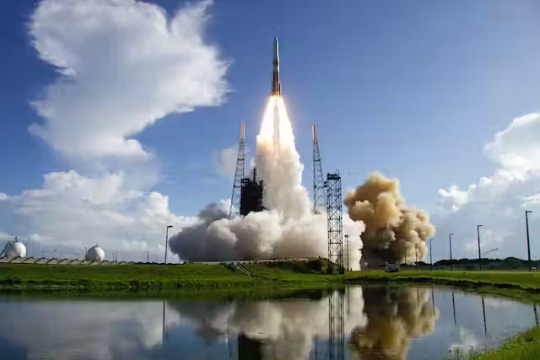
The year 2023 proved to be an important one for space missions, with NASA’s OSIRIS-REx mission returning a sample from an asteroid and India’s Chandrayaan-3 mission exploring the lunar south pole, and 2024 is shaping up to be another exciting year for space exploration.
Several new missions under NASA’s Artemis plan and Commercial Lunar Payload Services initiative will target the Moon.
The latter half of the year will feature several exciting launches, with the launch of the Martian Moons eXploration mission in September, Europa Clipper and Hera in October and Artemis II and VIPER to the Moon in November – if everything goes as planned.
I’m a planetary scientist, and here are six of the space missions I’m most excited to follow in 2024.
1. Europa Clipper
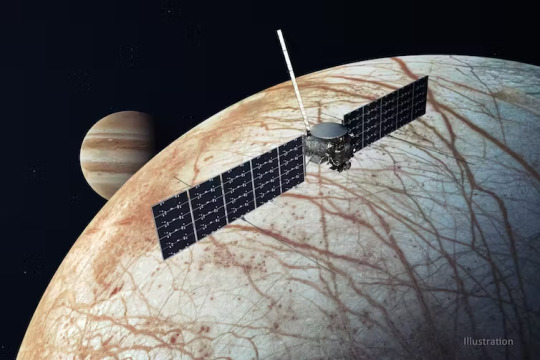
NASA will launch Europa Clipper, which will explore one of Jupiter’s largest moons, Europa. Europa is slightly smaller than Earth’s Moon, with a surface made of ice. Beneath its icy shell, Europa likely harbors a saltwater ocean, which scientists expect contains over twice as much water as all the oceans here on Earth combined.
With Europa Clipper, scientists want to investigate whether Europa’s ocean could be a suitable habitat for extraterrestrial life.
The mission plans to do this by flying past Europa nearly 50 times to study the moon’s icy shell, its surface’s geology and its subsurface ocean. The mission will also look for active geysers spewing out from Europa.
This mission will change the game for scientists hoping to understand ocean worlds like Europa.
The launch window – the period when the mission could launch and achieve its planned route – opens Oct. 10, 2024, and lasts 21 days. The spacecraft will launch on a SpaceX Falcon Heavy rocket and arrive at the Jupiter system in 2030.
2. Artemis II launch

The Artemis program, named after Apollo’s twin sister in Greek mythology, is NASA’s plan to go back to the Moon. It will send humans to the Moon for the first time since 1972, including the first woman and the first person of color. Artemis also includes plans for a longer-term, sustained presence in space that will prepare NASA for eventually sending people even farther – to Mars.
Artemis II is the first crewed step in this plan, with four astronauts planned to be on board during the 10-day mission.
The mission builds upon Artemis I, which sent an uncrewed capsule into orbit around the Moon in late 2022.
Artemis II will put the astronauts into orbit around the Moon before returning them home. It is currently planned for launch as early as November 2024. But there is a chance it will get pushed back to 2025, depending on whether all the necessary gear, such as spacesuits and oxygen equipment, is ready.
3. VIPER to search for water on the Moon
youtube
VIPER, which stands for Volatiles Investigating Polar Exploration Rover, is a robot the size of a golf cart that NASA will use to explore the Moon’s south pole in late 2024.
Originally scheduled for launch in 2023, NASA pushed the mission back to complete more tests on the lander system, which Astrobotic, a private company, developed as part of the Commercial Lunar Payload Services program.
This robotic mission is designed to search for volatiles, which are molecules that easily vaporize, like water and carbon dioxide, at lunar temperatures. These materials could provide resources for future human exploration on the Moon.
The VIPER robot will rely on batteries, heat pipes and radiators throughout its 100-day mission, as it navigates everything from the extreme heat of lunar daylight – when temperatures can reach 224 degrees Fahrenheit (107 degrees Celsius) – to the Moon’s frigid shadowed regions that can reach a mind-boggling -400 F (-240 C).
VIPER’s launch and delivery to the lunar surface is scheduled for November 2024.
4. Lunar Trailblazer and PRIME-1 missions

NASA has recently invested in a class of small, low-cost planetary missions called SIMPLEx, which stands for Small, Innovative Missions for PLanetary Exploration. These missions save costs by tagging along on other launches as what is called a rideshare, or secondary payload.
One example is the Lunar Trailblazer. Like VIPER, Lunar Trailblazer will look for water on the Moon.
But while VIPER will land on the Moon’s surface, studying a specific area near the south pole in detail, Lunar Trailblazer will orbit the Moon, measuring the temperature of the surface and mapping out the locations of water molecules across the globe.
Currently, Lunar Trailblazer is on track to be ready by early 2024.
However, because it is a secondary payload, Lunar Trailblazer’s launch timing depends on the primary payload’s launch readiness. The PRIME-1 mission, scheduled for a mid-2024 launch, is Lunar Trailblazer’s ride.
PRIME-1 will drill into the Moon – it’s a test run for the kind of drill that VIPER will use. But its launch date will likely depend on whether earlier launches go on time.
An earlier Commercial Lunar Payload Services mission with the same landing partner was pushed back to February 2024 at the earliest, and further delays could push back PRIME-1 and Lunar Trailblazer.
5. JAXA’s Martian Moon eXploration mission
youtube
While Earth’s Moon has many visitors – big and small, robotic and crewed – planned for 2024, Mars’ moons Phobos and Deimos will soon be getting a visitor as well. The Japanese Aerospace Exploration Agency, or JAXA, has a robotic mission in development called the Martian Moon eXploration, or MMX, planned for launch around September 2024.
The mission’s main science objective is to determine the origin of Mars’ moons. Scientists aren’t sure whether Phobos and Deimos are former asteroids that Mars captured into orbit with its gravity or if they formed out of debris that was already in orbit around Mars.
The spacecraft will spend three years around Mars conducting science operations to observe Phobos and Deimos. MMX will also land on Phobos’ surface and collect a sample before returning to Earth.
6. ESA’s Hera mission

Hera is a mission by the European Space Agency to return to the Didymos-Dimorphos asteroid system that NASA’s DART mission visited in 2022.
But DART didn’t just visit these asteroids, it collided with one of them to test a planetary defense technique called “kinetic impact.” DART hit Dimorphos with such force that it actually changed its orbit.
The kinetic impact technique smashes something into an object in order to alter its path. This could prove useful if humanity ever finds a potentially hazardous object on a collision course with Earth and needs to redirect it.
Hera will launch in October 2024, making its way in late 2026 to Didymos and Dimorphos, where it will study physical properties of the asteroids.
7 notes
·
View notes
Text
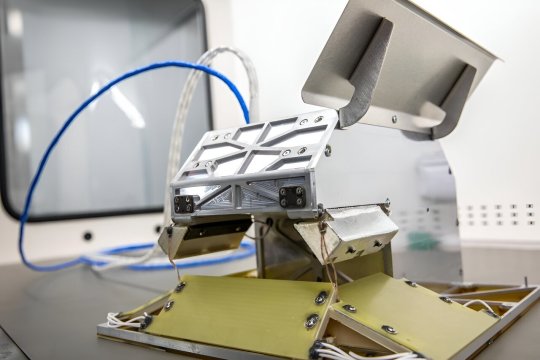
NASA technology helps guard against lunar dust
Defeating dust may be a small concern for most people on Earth, but for astronauts and spacecraft destined for the moon or Mars, it is a significant hazard that must be mitigated. That's why researchers at NASA's Kennedy Space Center in Florida are seeking innovative ways to use Electrodynamic Dust Shield (EDS) technology.
Using transparent electrodes and electric fields, EDS technology can electrically lift and remove dust from a variety of surfaces for space applications ranging from thermal radiators, solar panels, and camera lenses to spacesuits, boots, and helmet visors. Controlling and removing the statically-charged dust will be critical to the success of moon missions under the agency's' CLPS (Commercial Lunar Payload Services) initiative and Artemis campaign.
"For these CLPS and Artemis missions, dust exposure is a concern because the lunar surface is far different than what we're used to here," said Dr. Charles Buhler, lead research scientist at the Electrostatics and Surface Physics Laboratory at Kennedy. "Lunar regolith dust can get into gaskets and seals, into hatches, and even into habitats, which can pose a lot of issues for spacecraft and astronauts."
Unlike dust particles on Earth, dust on the moon's surface is sharp and abrasive—like tiny shards of glass—because it hasn't been exposed to weathering and elements like water and oxygen.
"Simply brushing lunar regolith across surfaces can make the problem worse because it's also very electrostatically charged and highly insulating," Buhler said.
Based on the Electric Curtain concept developed by NASA in 1967, EDS technology has been in development at Kennedy since 2004.
It first made its way to low Earth orbit aboard the NASA Materials International Space Station Experiment 11 mission in 2019. EDS technology was embedded in 12 different panels made of glass, polyimide, and prototype spacesuit fabric and sent to the International Space Station for testing in the vacuum of space.
Before making it to space, EDS had been predominantly tested in vacuum chambers that produced promising results of removing simulants and samples of lunar regolith, collected during NASA's Apollo missions, from surfaces within a second.
Most recently, as part of Intuitive Machines' first lunar lander mission, EDS technology was embedded in two lenses of EagleCam, a CubeSat camera system developed by students at Embry Riddle Aeronautical University in Daytona Beach, Florida. Following landing, the EagleCam instrument successfully deployed from Intuitive Machines' Odysseus lander. The teams at Embry Riddle were unable to acquire images of the lander as they had hoped, but they were able to collect other data sets, including from the EDS technology.
Later this year, another EDS technology demonstration is slated to land on the moon as part of NASA's CLPS initiative mission with commercial partner Firefly Aerospace.
"The team has put in a tremendous amount of work and dedication. EDS is considered the leading technology and the best we have for the removal of dust for space applications," Buhler said. "To fly as a dedicated payload on a mission to the moon is very exciting."
According to Buhler, EDS technology could be a first line of defense for establishing an extended human presence on the moon with future Artemis missions.
From its applications with protecting tools, machinery, and spacesuits, the technology could potentially even help improve day-to-day tasks by being applied to small components like gaskets, seals, and hatches. This could save astronauts the hassle of traveling to the moon with extra cleaning supplies.
"EDS technology can be used outside of a habitat to help clean surfaces like railings and floors, but it can be used inside as well," Buhler said. "All of those applications are being evaluated and tested."
IMAGE....Inside of the Electrostatics and Surface Physics Laboratory at NASA’s Kennedy Space Center in Florida, an electrodynamic dust shield (EDS) is in view on Jan. 18, 2023. The dust shield is one of the payloads to fly aboard Firefly Aerospace’s Blue Ghost lunar lander as part of NASA’s Commercial Lunar Payload Services (CLPS) initiative. Credit: NASA/Cory Huston
4 notes
·
View notes
Text
Where Are They Now - MTVs
With the introduction of the latest plan from NASA and the Olympus Partners to pursue not only a Martian program, but a Lunar one, it was ultimately deemed necessary to ensure that a new generation of Mars Transfer Vehicles continued to power crews out to the Red Planet without sacrificing capabilities. While the original nuclear thermal design had proved to be highly advantageous for the program, there were elements in which the design struggled - notably crew capacity and lack of full reuse characteristics. In 2020, a group at Marshall Space Flight Center, the very same birthplace of the first generation MTV, would gather to begin to design the next generation of spacecraft. Initial designs called for something referred to as the Deep Space Transport, or DST, highlighting the multi-mission nature of the vehicles, and centered much of their focus around a fully solar electric architecture using a large, rigid “workshop” module. Ultimately, this configuration would end up with intense power draw requirements and longer trip times, something that mission planners wanted to avoid in order to ensure maximum science return on the Red Planet itself. The next option explored would be a hybrid of sorts, a massive methalox chemical stage, supplemented by a nuclear powered VASIMIR thruster. These twin propulsion systems would work together for various phases of flight, with the Nuclear-Electric element doing the outward push, and the chemical stage performing the arrival burn at both Mars and departure from when the time came. Post arrival, the electric stage would ignite once more to slowly spiral down to the Low Martian Orbit customary of Olympus operations, where the vehicle would rendezvous with the Base Station and MADV for the sortie to the Martian Surface.

Endurance conducts her first test of the new VASIMIR system, fed by a powerful nuclear reactor.
In December 2027, after a long and arduous design period, the first launch of the newly named Armstrong Class MTV Endurance would be conducted by Jupiter-OPAV, carrying the largest single element - the chemical transfer stage. This would see Adventure pushed to her absolute limits, having recently completed her Block III upgrades. After a flawless flight to orbit, the great chemical stage would separate and coast free, with the OPAV pod returning to land in the California desert. Over 7 additional launches, the inflatable habitat, workshop, node and truss segments would be launched to the growing vehicle. In March of 2028, she would be visited by the crew of ACEV Kitty Hawk for checkout once the reactor had been delivered, configuring her for her service life. She was an impressive vehicle, with MTV Endurance acting not only as a fully functional Mars Transfer Vehicle, but a testbed for technologies needed to augment future human spaceflight endeavors. Her first crew would marvel at her size, and conduct final bolt tightening and maintenance work before her series of practice burns over the next few months, simulating various maneuvers. With a successful electric thruster demonstration under her belt, she would be topped up by a series of new, commercially and internationally launched methane tankers In June of 2028, Endurance would receive her crew onboard ACEV Columbia, having launched only 12 hours prior onboard an Atlas EvO. Their international crew consisted of members who had only been children when the first rotations to the Red Planet had begun, finally fulfilling their dream of walking on worlds unknown. Olympus 19 would cast off from planet Earth only 8 days after their arrival, conducting a 6 month voyage to Mars to further research at Foundation. Soon, Endurance’s sister ships would be brought online one by one, Constellation and Pathfinder - to continue the dream of human exploration of Mars. This dramatic capability increase would also see the need arise for a second MADV, to support larger crews operating around Mars. Enterprise’s sister ship, Phoenix, would be launched to Low Martian Orbit to support crews of up to 16 at Foundation as the complex expanded dramatically.

Endurance waits patiently in orbit for her maiden voyage, a gargantuan undertaking finally complete - ready to power the future of human endeavors in spaceflight.
Minerva herself had already been modified in support of Destiny, removing her drop tank mounting points and habitation section, with those components being returned to LEO for servicing and potential conversion. What remained of her now was the core fuel tanks, solar arrays, a cargo mounting point for the Altair Common Lunar Lander, and her avionics ring. To spaceflight enthusiasts, she was a shell of her former self, but in the eyes of the Mission Planning Office, she was right where they needed her to be. An international crew of 6, commanded by Olympus 15 veteran Lance Novak would set off from Earth in August 2027, launching onboard ACEV Columbia for the short journey to the Moon. Minerva would brake into an elliptical orbit, high above the gravitational anomalies that limited Apollo’s stay in lunar orbit. On August 28th, 2027, the crew of Destiny III would board their lander, Artemis, and make the descent to the Lunar surface, aiming for the rim of Shackleton Base. Their lander, a joint project between NASA, ESA and JAXA locked on to the Russian built beacon already in place onboard their cargo lander, and soon the crew of 6 could begin their initial operations, setting up a permanent, rapidly expandable base on the Lunar surface. Prometheus and Selene would soon see retirement from Martian sorties as the Armstrong Class ramped up their operational cadence. They would spend their golden years here, servicing the Earth-Moon system as they ferried crews, cargo and more between the growing base at Shackleton, supporting crucial operations as the population of the moon rapidly grew through the 2030s. Soon, the needs of the growing base would surpass that of the original MTVs, and the great ships would be broken up in Lunar orbit, with usable components brought down to the surface to expand the growing base. Tanks would be repurposed for hydrogen storage, vital in support of the growing demands of fuel production. The MTVs would find themselves living out their days incorporated into human architectures, spread out across the lunar surface. Well, nearly all of them.
Hera’s time in service ended long before her sisters. Due to the damage sustained by Chris Taylor’s impact along with the structural failure of the robot arm, the helium coolant circuit and one of the redundant ammonia circuits were emptied long before her arrival at the world of her birth. Through the careful management of propellant and power, flight controllers were able to keep her alive all the way back to Earth. In the absence of coolant, bled off into the vacuum of space, the Valkyrie engines had their control drums locked in the neutral position and had the xenon quench fired shortly before entering the Earth-Moon system to ensure the reactors would never start again. Hera had built up too much energy during the abort to be captured at earth. She would be forced to leave her crew behind as she threw herself past their home. The final act of her propulsion system would be supporting the safe separation of the Lifeboat, burning the last of the hydrazine propellant, the last drops of her blood, to increase separation from her precious crew and give them the best odds of making it home. NASA had good reason to believe heliocentric space would become much busier in the future, and since she could not be tracked on her solo trek around the sun, Hera was made to pose as little of a hazard as possible. Hera had mostly been bled dry but as a final precaution, all her propellant tanks were opened to vacuum to minimize the risk of a breakup. One by one her batteries were discharged and isolated from the solar panels to prevent their explosion. The team behind each subsystem said their goodbyes as their respective computer, pump, or gyroscope was turned off for the final time. The final command sent was to turn off the remaining CMG and broadcast the abort repeater tone indefinitely. The message ended with a text string to be read by no one. “Thank you Hera. Rest well” Back on Earth, Hera’s lifeboat was placed on display in an annex built onto building 30 at JSC. New flight controllers are brought into the room on their third day of training where the audio recorded onboard Hera during the abort is played back, a reminder of painful day's past. The intent is to not only remind them of the stakes of the job but demonstrate that they will never run out of options in their fight to bring a crew home safe. Hera herself orbits silently between earth and Venus. Over many years a tumble slowly developed from the uneven pressure exerted on the two remaining radiators and the reflective MLI on her tanks. Despite this - she remained intact and never experienced a close encounter with any planet again. She remains the only original Olympus hardware that is left unperturbed or unmodified, free to silently observe humanity's future in the solar system.
Photos by Jay
Additional Writing by Posstronaut Peter
Read Proxima here
#alt history#alternate history#proxima: a human exploration of mars#proxima#space#space travel#space exploration#alternate future#mars transfer vehicle#future tech#technology#worldbuilding
13 notes
·
View notes
Link
It’s been another great year at NASA’s Ames Research Center in California’s Silicon Valley. Join us as we review some of the highlights of the science, engineering, and innovation from 2023. Announcing a New Innovation Hub Planned for NASA Research Park at Ames NASA Berkeley Space Center is a proposed new campus of the University of California, Berkeley, and an innovation hub for research and advances in astronautics, aeronautics, quantum computing, climate studies, and more. Planning to join Ames as a tenant of our NASA Research Park in Silicon Valley, the new campus aims to bring together researchers from the private sector, academia, and the government to tackle the complex scientific, technological, and societal issues facing our world. Mapping Water Distribution on the Moon’s South Pole NASA Using data collected by the now-retired Stratospheric Observatory for Infrared Astronomy (SOFIA), researchers shared the first detailed, wide-area map of water distribution on the Moon. Understanding how much water lies beneath the lunar surface, and how it’s distributed, will help guide future missions like VIPER, as well as prospective sites for human habitats. Colliding Moons May Have Formed Saturn’s Rings NASA New research suggests Saturn’s icy moons and rings were formed by a collision a few hundred million years ago, creating debris that gathered into the planet’s dusty, icy rings or clumped together to form moons. NASA and Airlines Partner to Save Fuel and Reduce Delays NASA/James Blair This year, NASA partnered with five major U.S. airlines on an air traffic decision-making tool that saved more than 24,000 pounds of jet fuel in 2022 for flights departing from Dallas-Fort Worth International Airport and Dallas Love Field Airport. Partners include American Airlines, Delta Air Lines, JetBlue Airways, Southwest Airlines and United Airlines. NASA Leaders View Climate Science, Wildfire Innovations at Ames NASA/Dominic Hart NASA’s top leadership, industry experts, and legislative officials visited Ames in April to learn about about the center’s climate science efforts and innovations in aeronautics that will help scientists and engineers better understand climate change and mitigate natural disasters like wildland fires. Starling Takes Flight Blue Canyon Technologies/NASA In July NASA’s Starling mission, managed at Ames, launched four CubeSats into low-Earth orbit to test robotic swarm technologies for space. You can track mission milestones via the Small Satellite Missions blog, and follow the mission live in NASA’s Eyes on the Solar System 3D visualization. NASA’s First Robotic Moon Rover NASA/Robert Markowitz This year engineers began assembling NASA’s first robotic Moon rover, VIPER — short for the Volatiles Investigating Polar Exploration Rover — and the agency is giving the public a front row seat to watch along as the rover takes shape. While individual components, such as the rover’s science instruments, lights, and wheels, were assembled and tested, the VIPER team also completed software development, mission planning, and tricky tests of the rover’s ability to drive off the Astrobotic Griffin lunar lander and onto the lunar surface. Bringing Home Ancient Space Rocks NASA/Keegan Barber NASA’s OSIRIS-REx mission – short for the Origins, Spectral Interpretation, Resource Identification, and Security-Regolith Explorer – returned to Earth in Sept. 2023, bringing with it extraterrestrial rocks and dust that it scooped up from an asteroid estimated to be 4.5 billion years old. Ames contributed to the spacecraft’s heat shield, anti-contamination systems, post-landing sample curation, and more. Preparing to Send Yeast to the Moon’s Surface for Astronaut Health NASA/Dominic Hart NASA’s plans to explore the Moon and eventually go to Mars will bring humans deeper into space for longer duration missions than ever before. These extended missions beyond low Earth orbit pose certain health risks to astronauts. The Lunar Explorer Instrument for Space Biology Applications team is preparing an experiment to study yeast’s biological response to the lunar environment to help understand and mitigate health risks for astronauts. X-59 Team Moves Toward First Flight in 2024 Lockheed Martin/Gary Tice This year, NASA’s X-59 team installed the finishing touches to the aircraft’s tail structure and moved it from its assembly facility to the flight line to perform structural testing. The X-59 quiet supersonic aircraft will take its first flight in 2024. Celebrating a Stellar Year for Webb Telescope Science NASA, ESA, CSA, STScI, and S. Crowe (University of Virginia) The James Webb Space Telescope’s Near-Infrared Camera instrument produced a feast for the eyes with a view into a star-forming region, named Sagittarius C, in the heart of the Milky Way. The image reveals a portion of the dense center of our galaxy in unprecedented detail, including never-before-seen features astronomers have yet to explain. Supercomputer Simulations Lead to Air and Space Innovations NASA Simulations and models developed using technology at the NASA Advanced Supercomputing Facility (NAS) help researchers and engineers develop innovations in air and space. Modeling turbofan engines could lead to designs that reduce engine noise and improve efficiency by understanding where noise is generated inside the machine. S-MODE Sails the Seas and Soars through the Sky NASA/Avery Snyder The Sub-Mesoscale Ocean Dynamics Experiment (S-MODE) logged its final field expedition, and they took a team from the TODAY Show along for the ride. S-MODE combined airborne instruments, research ships, and autonomous ocean gliders to get an unprecedented look at how gas and heat exchange at the ocean’s surface impacts Earth’s climate. From Intern to Astronaut, and Back to Ames NASA/Dominic Hart NASA astronaut Jessica Watkins, who was once an intern at Ames, returned to the Bay Area in Feb. 2023 to visit with local elementary schools and speak with Ames employees. Watkins started her career with NASA at Ames, where she conducted research on Mars soil simulant supporting the Phoenix Mars Lander mission. Second Gentleman Joins East Bay Kids for STEM Activities NASA/Dominic Hart Nearly 100 East Bay kids and their families got to experience the thrill of “launching a rocket” and “making clouds” at a fun-filled STEM event hosted in honor of Women’s History Month at the East Oakland Youth Development Center in Oakland, California, in March 2023. Second Gentleman Douglas Emhoff, NASA Ames Research Center Director Dr. Eugene Tu, and NASA astronaut Dr. Yvonne Cagle joined kids at the Manzanita Community School for hands-on activities and to distribute approximately 500 STEM Artemis Learning Lunchboxes aimed to inspire the Artemis generation to learn about NASA’s Artemis Program. Top Leaders in Our Midst Hailed from the White House and Australia NASA/Dominic Hart In January, U.S. President Joe Biden landed at Moffett Federal Airfield, at Ames, on his way to visit storm-damaged regions in the state. Research conducted at our Silicon Valley center could help predict extreme climate-related weather events. Later in the spring, Vice President Kamala Harris arrived at Moffett before delivering remarks at a local company, and leaders of the Australian Space Agency visited Ames to learn about the center’s missions supporting NASA’s Artemis program, including the VIPER Moon rover, which will launch to the lunar South Pole in late 2024.
2 notes
·
View notes
Text
Lunar colonies
https://www.washingtonpost.com/technology/2023/07/25/nasa-moon-artemis/
NASA took a significant step Tuesday toward allowing humans on the moon to “live off the land,” awarding several contracts to build landing pads, roads and habitats on the lunar surface, use nuclear power for energy, and even lay a high-voltage power line over half a mile.
In all, the agency is investing a total of $150 million, while the 11 companies that received awards are required to invest their own money to pay at least 10 to 25 percent of their projects’ costs.
The awards come as NASA is working to return astronauts to the lunar surface for the first time since 1972. Under its Artemis program, NASA intends to fly a crew of four around the moon by the end of 2024, with a landing to come as early as 2025, though the schedules of those missions could slip.
Instead of going to the moon and returning home, as was done during the Apollo era of the 1960s and early ’70s, NASA intends to build a sustainable presence focusing on the lunar South Pole, where there is water in the form of ice. The contracts awarded Tuesday are some of the first steps the agency is taking toward developing the technologies that would allow humans to live for extended periods of time on the moon and in deep space....
5 notes
·
View notes
Text
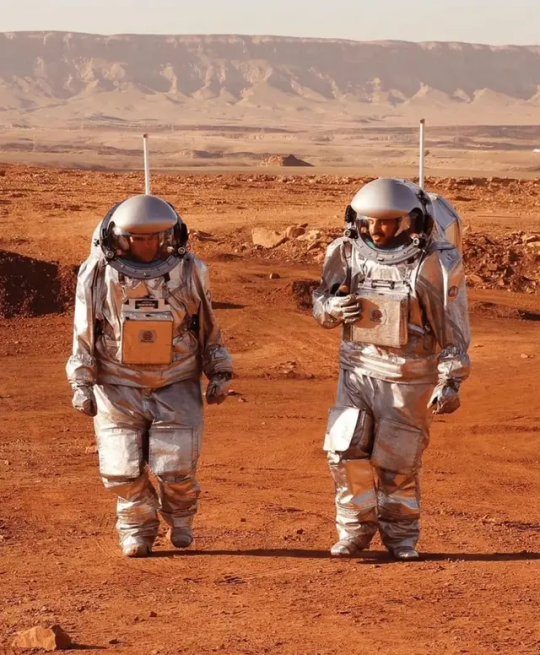

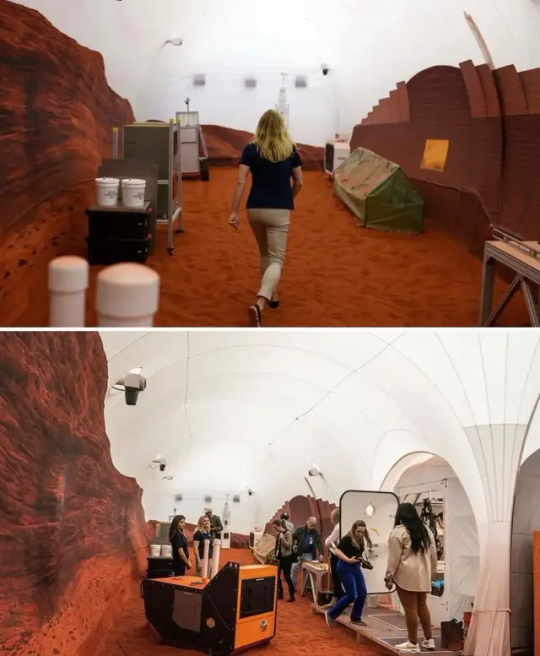
A group of four NASA volunteers has embarked on a 378-day mission in which they will be locked in a ground-based simulation of the planet Mars. The mission, which began on Sunday, is the first of three year-long Mars surface simulations, according to NASA. During the mission, crew members will live and work in a 3D-printed, 1,700-square-foot habitat. NASA says researchers will simulate the challenges of a human mission to Mars, including resource limitations, equipment failure, and communication delays.
#sailor mars#mars mission#marsrover#moon#space science#space exploration#astronomy news#spacecraft#spaceship#space#space advances#space adventures#news#science#astronomy#outer space#research#universo
2 notes
·
View notes
Text
Climate
Climate is still controversial? Yes. I’m reminded every time I post a climate story and a denier pops up.
Why do I care about climate? Climate impacts everything. Food chain, jobs, housing, health, animals, plants, etc. I’m saving info so I can find it again. To learn - about trends, land use, natural patterns, and habitats. (I try to be aware of science funded by corporate interests. See Toxic Sludge Is Good For You)
“When Did Climate Science Begin?”
How 19th Century Scientists Predicted Global Warming | Jstor.org
1824 & 1837 Papers by Joseph Fourier, a French mathematician and physicist who spent his career pondering the mechanics and equations governing heat transfer.
1856 Eunice Newton Foote experimented with heat trapping gases (CO2) and wrote a paper for The American Journal of Science. Interesting factoid: “When time came to present her research before the American Association for the Advancement of Science—among the country’s most eminent scientific gatherings—they didn’t allow women to speak, so it was read by a male colleague.”
“Nature changes all the time! Why worry?”
What’s the Difference Between Weather and Climate? | NASA
The difference between weather and climate is a measure of time.
Weather is what conditions of the atmosphere are over a short period of time.
Climate is how the atmosphere "behaves" over relatively long periods of time.
In addition to long-term climate change, there are shorter term climate variations. This so-called climate variability can be represented by periodic or intermittent changes related to El Niño, La Niña, volcanic eruptions, or other changes in the Earth system.
United States Global Change Research Program (USGCRP)
“Thousands of studies conducted by researchers around the world have documented increases in temperature at Earth’s surface, as well as in the atmosphere and oceans. Many other aspects of global climate are changing as well. Human activities, especially emissions of heat-trapping greenhouse gases from fossil fuel combustion, deforestation, and land-use change, are the primary driver of the climate changes observed in the industrial era.”
Climate science is not new. Is not a fad.
The climate scientists are talking - Will we listen?
#climate change#weather#global temperature#earth#science#natural habitat#farm and ranch#gardening#urban planning
3 notes
·
View notes
Text
Space habitat reports – May.6.2024
Here is this week's selection of videos and news items about space habitats, living in space, and space settlement.
=== International Space Station & NASA
https://youtu.be/zowLYdbSBG4
** Space Station Crew Talks with Syracuse.com - The Post-Standard - Friday, May 3, 2024 - NASA Video
Aboard the International Space Station, Expedition 71 Flight Engineers Jeanette Epps and Matt Dominick of NASA discussed life and work aboard the orbital outpost during an in-flight interview May 3 with the Post-Standard/Syracuse.com. Epps and Dominick are in the midst of a long-duration mission aboard the microgravity laboratory to advance scientific knowledge and demonstrate new technologies for future human and robotic exploration flights as part of NASA’s Moon and Mars exploration approach, including lunar missions through NASA’s Artemis program.
https://youtu.be/aNHLii4p2MY
** SpaceX Crew-8 Dragon relocation - SciNews
SpaceX’s Crew-8 “Endeavour” Crew Dragon spacecraft, with NASA astronauts Matthew Dominick, Michael Barratt, Jeanette Epps and Roscosmos cosmonaut Alexander Grebenkin, was relocated from the forward-facing port to the space-facing port of the International Space Station’s Harmony module, on 2 May 2024. The relocation was performed in order to make way for the arrival of for the CST-100 Starliner spacecraft on Boeing’s Crew Flight Test, currently scheduled for 6 May 2024. The “Endeavour” Crew Dragon previously supported the Demo-2, Crew-2, Ax-1 and Crew-6 missions.
Credits: NASA/SpaceX
https://youtu.be/b7G5SCvJQ7o
=== Commercial space habitats
** Axiom Space tests their lunar spacesuit in the Neutral Buoyance Laboratory at NASA's Johnson Space Center in Houston:
.@Axiom_Space recently tested its AxEMU lunar spacesuit for the first time at @NASA's Neutral Buoyancy Laboratory. The uncrewed suit was submerged underwater to simulate the 1/6th gravity environment of the Moon to test its pressure garment system. Future testing at the pool will… pic.twitter.com/z4BODTJ7xZ
— NASA's Johnson Space Center (@NASA_Johnson) April 30, 2024
** Testing underway for Axiom's "Axiom Extravehicular Mobility Unit (AxEMU)" space suit for lunar surface activities:
With the successful conclusion of this trial run, the next NBL suit run will have our very own astronaut inside ... stay tuned!
Learn more about the #AxEMU, our next-generation spacesuit that will support humanity's return to the moon at https://t.co/eP6HiSUy2E
— Axiom Space (@Axiom_Space) April 29, 2024
** Sierra Space shows the development path for their inflatable space stations
Our company is leading the charge towards a science and biopharma platform designed to allow humans to live and work in LEO and beyond. As the ISS heads towards retirement, the future of space will revolve around the first commercial space station.https://t.co/FttqPaibeJ pic.twitter.com/Z0GOEJJXyw
— Sierra Space (@SierraSpaceCo) May 1, 2024
See the blog post at Building the World’s First Commercial Space Station | Sierra Space - Apr.30.2024
Our LIFE (Large Integrated Flexible Environment) technology launches on a conventional rocket. Its inflatable structure remains tightly packed upon deployment. One of the first in our product line, LIFE 285, will inflate into a structure that is three stories tall and 27 feet in diameter once it reaches space—essentially the size of a three-story apartment, with each floor being nine feet tall.
The inflatable structural shell is made up of a tightly woven fabric (Vectran) that’s up to five times stronger than steel once inflated and offers a balance of properties unmatched by other high-performance fibers. This strong structural shell, as well as its spacious interior, makes it perfect for both LEO and long-duration missions to the moon, Mars and the stars.
Why an inflatable softgoods shell? The problem with large, metallic space stations is that they’re hard (and expensive) to launch into space. That’s where the magic of an inflatable spacecraft comes into play. Launched in a packed state, it can easily reach space and expand to huge volumes.
Once fully inflated, the interior of LIFE 285 will be able to accommodate anywhere from four to twelve people, depending on the purpose and length of the mission.
It can also be fully packed with essential supplies and work space tools, including an Astro Garden® for a constant supply of fresh produce, ample sleeping quarters, a medic chamber, and exercise equipment. It will help serve as a place where innovations and groundbreaking research come together for longer duration space missions.
---- Sierra continues pressure tests of the inflatable module structures:
#ICYMI: We will be conducting our second full-scale structure test of our expandable space station technology next month at @NASA_Marshall in Huntsville, AL.
Stay tuned. pic.twitter.com/2xbePlA89o
— Sierra Space (@SierraSpaceCo) May 3, 2024
** VAST
Excited to show that we are building the world’s first commercial space station @vast Haven-1! This month we completed our VAST Haven-1 primary structure pathfinder which proved we could build in house all the critical geometries, transitions, and interfaces of Haven-1. Next up -… pic.twitter.com/uF73g79wry
— Max Haot (@maxhaot) April 29, 2024
=== Chinese space habitats
** Shenzhou-17 undocking - SciNews
The Shenzhou-17 (神舟十七) crew spacecraft undocked from the Tianhe Core Module (天和核心舱), departing the China Space Station (中国空间站), on 30 April 2024, at 00:43 UTC (08:43 China Standard Time). The Shenzhou-17 spacecraft is expected to make a parachute-assisted landing at the Dongfeng landing site, Inner Mongolia Autonomous Region, China, returning the sixth crew of three astronauts on a mission to the China Space Station (中国空间站): Hongbo Tang (汤洪波, commander), Shengjie Tang (唐胜杰) and Xinlin Jiang (江新林).
https://youtu.be/KBPKYrr6tpk
** Research Aboard China Space Station to Probe Origins of Life - CCTV Video News Agency
The China Space Station will undertake a number of new experiments during the Shenzhou-18 mission that may help answer key questions about the origins of life and work toward breakthroughs in medicine and spaceflight engineering.
https://youtu.be/xbd3GnEi3vo
=== Lunar habitation
** DARPA-backed study examines architectures for lunar bases.
The Lunar Surface Innovation Consortium (LSIC) is a NASA supported organization based at Johns Hopkins Applied Physics Lab (JHU/APL). LSIC recently hosted a meeting for DARPA's 10-Year Lunar Architecture (LunA-10), a seven month program that
aims to rapidly develop foundational technology concepts that move away from individual scientific efforts within isolated, self-sufficient systems, toward a series of shareable, scalable systems that interoperate — minimizing lunar footprint and creating monetizable services for future lunar users.
Participant teams in LunA-10 presented their findings at the LSIC meeting. Here, for example, are some slides from SpaceX, which presented plans for development of a lunar base using Starships:
Some SpaceX charts showing how the company believes it can use Starship to establish a lunar base (from its DARPA LunaA-10 study, being discussed today at the LSIC meeting.) pic.twitter.com/NPRc2UoiD4
— Jeff Foust (@jeff_foust) April 25, 2024
Presentations from all the teams are available in this document (pdf).
For even more about lunar base technologies, see the presentation, NASA Lunar Surface Operations & Power Grid (pdf), given by Jeffrey Csank of NASA Glenn Research Center at a 2023 meeting.
** China is Building a Lunar Satellite Constellation - Dongfang Hour - YouTube
As China ramps up its lunar exploration program in the coming decade, space-based lunar infrastructure is going to be a key enabler. Spacecraft and ground-based vehicles will increasingly need positioning and communication services, which is why China has launched a plan to establish a lunar satellite constellation called the "Queqiao constellation". The focus on the back side and the lunar south pole also means that communications will require relay satellites.
In preparation for this lunar constellation, expected in the 2030s, China has been launching single Queqiao spacecraft: the "Queqiao" in 2018, "Queqiao-2" in March 2024, and "Queqiao-3" by the end of the decade.
In this video, we cover this quest for lunar infrastructure, a low key but essential milestone for the establishment of China's future lunar outpost, the ILRS.
If you like what you see and would like to support me, please consider joining our small Patreon community at / dongfanghour !
We also have some very cool space merch available at https://shop.dongfanghour.com .
00:00 Introduction
00:17 Lunar exploration & tidal locking
01:11 Queqiao-1 and Queqiao-2 relay missions
03:11 Launching the Queqiao lunar constellation
05:47 Equivalent projects by NASA and ESA
https://youtu.be/hrnEIvPoTT4
See also China’s Next Moon Lander – Ready for Sample-collecting Sendoff | Leonard David - Apr.28.2024.
** China unveils international moon base concept animation - VideoFromSpace
China has unveiled a concept video for a international research base on the moon.
https://youtu.be/2YOvsJXsAQE
=== Mars habitation
- NASA Selects Commercial Service Studies to Enable Mars Robotic Science | NASA - May.3.2024
- Starlink on Mars? NASA Is Paying SpaceX to Look Into the Idea | Universe Today - May.3.2024
=== Future space habitat designs
** How Robots Will Help Humans Conquer The Moon - Fraser Cain
When humans will return to the Moon they will need a lot of assistance to set up a settlement and carry out all the missions. They will need a lot of robots to do that. How exactly will it pan out? Figuring out with Professor Yang Gao from King's College London.
https://youtu.be/j4K75MIlRz0
** When you hear "Bernal Sphere"... - SSI: Space Studies Institute Youtube - SSI Website
Just a little video for fun.
Oh, and this design isn't public domain. Just sayin'. Credit where credit is due please, and Thank you.
Want to know the story of "The Model"? Look here: https://ssi.org/an-oneill-colony-in-s...
And scroll down to the bottom to see what is and what is not a "Bernal Sphere" ...and why.
https://youtu.be/KqKxFPv7qvk
** Jerry Stone illustrates Island 0, a Gerard O'Neill Island 1 demonstrator - Space Renaissance
Jerry Stone illustrates Island 0, a Gerard O'Neill Island 1 demonstrator, in the frame of the Expanding Humanity To Outer Space International Cooperation Youth Event (EHTOS)
Moderator: Ghanim Alotaibi
Lecturer: Jerry Stone
Participants: Werner Grandl, Guy çignolet, Mahhad, B. Daniel, Adriano V. Autino
https://youtu.be/HxOv2Q9B6Jw
=== Polaris Program - SpaceX EVA suit unveiled. Will be used on first Polaris mission
On May 4th, the Extravehicular Activity (EVA) Suit designed by SpaceX was unveiled to the public. The initial application of the suit will be during the Polaris Dawn mission, which aims to reach the highest altitude yet for a Dragon spacecraft. They will attempt also to carry out the first EVA by private astronauts.
At approximately 700 kilometers above the Earth, the crew will attempt the first-ever commercial extravehicular activity (EVA) with SpaceX-designed extravehicular activity (EVA) spacesuits, upgraded from the current intravehicular (IVA) suit. Building a base on the Moon and a city on Mars will require thousands of spacesuits; the development of this suit and the execution of the EVA will be important steps toward a scalable design for spacesuits on future long-duration missions.
The Dragon has no airlock so when the hatch is opened, all four crew members must be in suits.
- SpaceX unveils Extravehicular Activity suit to be used during Polaris Dawn mission | Polaris Program - May.4.2024
- Online chat with the Polaris Dawn crew and SpaceX team | X.com - May.4.2024
- The Extravehicular Activity (EVA) Suit | SpaceX Updates - May.4.2024
- SpaceX - Human Spaceflight - Description of the SpaceX suits for intravehicular and extravehicular activities.
More @SpaceX photos of the new Extravehicular Activity (EVA) suit the Polaris Dawn crew will wear during their upcoming mission. Let us know your questions below ahead of today’s X Spaces event with the crew and SpaceX team https://t.co/tLdnzAVtCS pic.twitter.com/2ptb2IuQJo
— Polaris (@PolarisProgram) May 4, 2024
=== The Extravehicular Activity (EVA) Suit - SpaceX Youtube
At ~700 km above Earth, the EVA suit will support the Polaris Dawn crew in the vacuum of space during the first-ever commercial astronaut spacewalk.
Evolved from the Intravehicular Activity (IVA) suit, the EVA suit provides greater mobility, a state-of-the-art helmet Heads-Up Display (HUD) and camera, new thermal management textiles, and materials borrowed from Falcon’s interstage and Dragon’s trunk.
Building a base on the Moon and a city on Mars will require millions of spacesuits. The development of this suit and the execution of the spacewalk will be important steps toward a scalable design for spacesuits on future long-duration missions as life becomes multiplanetary.
https://youtu.be/fdELVCg2Ank
=== Other space habitat and settlement news and articles:
- Calendar:
- Webinar: What It Will Take To Build Communities In Space | Beyond Earth Institute, April 25, 2024, 1:00-2:30 pm
- ISDC | International Space Development Conference, Los Angeles, CA, Thursday, May 23rd to Sunday, May 26th, 2024
- 13th annual International Space Station Research and Development Conference (ISSRDC 2024) - July 30-August 1, 2024, Boston.
- ISS:
- Crew Works Payloads and Training, Awaits Starliner Arrival | Space Station/NASA - May.3.2024
- Dragon Moves to New Port, Makes Way for Starliner | Space Station/NASA - May.2.2024
- ISS Roundup: an eclipse, an EVA, and more than just science returns to Earth| NASASpaceFlight.com - Apr.30.2024
- Dragon Spacecraft Splashes Down Completing Resupply Mission | Space Station/NASA - Apr.30.2024
-
Read the full article
0 notes
Text
End Up the Heat: A Spicy Crispy Chicken Burger Recipe to Enjoy
In recent years, the prospect of human colonization on Mars has captured the imagination of scientists, engineers, and space enthusiasts alike. With ambitious missions planned by space agencies and private companies, the dream of establishing a sustainable human presence on the Red Planet is no longer confined to science fiction. But will humans truly be able to live on Mars in the future, or is it just a far-fetched fantasy?
The Mars Challenge: Overcoming Barriers to Colonization
Mars presents a multitude of challenges that must be addressed before humans can inhabit its harsh environment. One of the most critical obstacles is the planet's thin atmosphere, which lacks the protective ozone layer found on Earth. This exposes Mars to high levels of radiation from the sun and cosmic rays, posing significant risks to human health.
Additionally, Mars has extreme temperatures, with average surface temperatures hovering around minus 80 degrees Fahrenheit (-62 degrees Celsius). Surviving in such frigid conditions will require advanced technology and infrastructure to provide adequate heating and protection for habitats and inhabitants.
Another major challenge is the lack of readily available resources on Mars. Unlike Earth, Mars does not have abundant water, fertile soil, or a breathable atmosphere. Therefore, any human settlement on Mars would need to rely on innovative methods of resource extraction, recycling, and conservation to sustain life.
Progress Toward Martian Habitation: Current Initiatives and Technologies
Despite these formidable challenges, significant strides have been made toward realizing the vision of Martian colonization. NASA's Mars Exploration Program, along with initiatives by SpaceX and other space agencies and organizations, are actively working on developing the necessary technologies and infrastructure for human missions to Mars. realcoder.net
Key areas of focus include:
Spacecraft and Launch Systems: Developing spacecraft capable of safely transporting humans to Mars and back, as well as designing efficient launch systems for sending cargo and equipment to the planet.
Habitat Design and Construction: Designing habitats that can withstand the Martian environment and provide a safe and comfortable living space for astronauts. This includes considerations such as radiation shielding, life support systems, and waste recycling.
Resource Utilization: Investigating methods for extracting water from Martian ice deposits, producing oxygen from the atmosphere, and utilizing local materials for construction and manufacturing.
Robotic Exploration: Deploying robotic rovers and landers to conduct reconnaissance and gather data on the Martian surface, including potential landing sites and resources.
The Path Forward: Challenges and Opportunities
While significant progress has been made in advancing the technology and infrastructure needed for human colonization of Mars, many challenges remain to be overcome. These include mitigating the health risks associated with long-duration space travel, developing sustainable food production systems, and addressing psychological factors such as isolation and confinement.
Furthermore, the cost of Martian exploration and colonization is substantial, requiring significant investments from governments, private companies, and international partnerships. Balancing the scientific, technical, and ethical considerations involved in sending humans to another planet will also be crucial in shaping the future of Martian exploration.
Despite these challenges, the prospect of humans living on Mars offers numerous opportunities for scientific discovery, technological innovation, and international cooperation. By pushing the boundaries of human exploration and expanding our presence beyond Earth, we may unlock new insights into the origins of life, the potential for life elsewhere in the universe, and our own place in the cosmos.
Conclusion
The question of whether humans will be able to live on Mars in the future is a complex and multifaceted one, with no easy answers. While significant hurdles remain to be overcome, ongoing advancements in space exploration and technology bring us closer than ever to realizing the dream of Martian colonization. Whether or not humans ultimately establish a permanent presence on the Red Planet will depend on our ability to overcome the challenges of space travel, harness the resources of Mars, and adapt to life in an alien environment.
0 notes